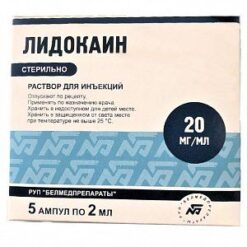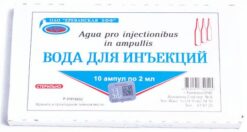No products in the cart.
Uman albumin 20%, 50 ml
€1.00
Out of stock
(E-mail when Stock is available)
EAN: 4607003390662
SKU: 117749
Categories: Anesthesia and resuscitation, Anesthesia solutions, Medicine
Description
Uman albumin is a plasma substitute obtained by fractionation of blood and plasma of healthy donors.
Albumin is a protein with a molecular weight of 69000 dalton, which is an integral part of the protein fraction of human blood.
It replenishes blood plasma albumin deficiency, maintains colloidal-osmotic (oncotic) blood pressure, rapidly increases blood pressure and total blood circulation, promotes fluid transfer from the tissue into the bloodstream and has detoxifying properties.
Indications
Indications
Active ingredient
Active ingredient
Composition
Composition
1 ml contains human albumin 200 mg
Additives:
Sodium chloride,
Sodium caprylate,
Acetyltryptophan,
water d/i.
How to take, the dosage
How to take, the dosage
The dosing regimen and infusion rate are calculated based on the individual patient.
The minimum colloidal osmotic pressure is 20 mmHg (2.7 kPa).
When prescribing human albumin, the required dose in grams can be calculated using the following formula:
[required total protein (g/L) – available total protein (g/L)] Ã plasma volume (L) Ã 2.
The physiological plasma volume can be calculated as corresponding to 40 ml/kg body weight.
As this formula is approximate in some cases, laboratory monitoring of protein concentration is recommended. In case of extensive replacement therapy and if hematocrit drops below 30%, transfusion of red blood cell mass is necessary to maintain blood oxygen transport.
The drug is administered only by IV drip.
The infusion rate is determined in accordance with individual characteristics and indications; as a rule, for 5% solution – 5 ml/min, for 20% and 25% solutions – 1-2 ml/min. Maximum infusion time is 3 hours. During plasmapheresis infusion rate should not exceed 30 ml/min.
When administering large amounts, the drug should be warmed to room temperature or body temperature before use.
Interaction
Interaction
To date, no interactions of human albumin with other medicinal products have been reported.
The drug should not be mixed with other drugs, blood or red blood cell masses as this may cause protein precipitation.
Special Instructions
Special Instructions
The colloidal-osmotic pressure of 20% albumin solution is 4 times that of blood plasma. Therefore, when concentrated albumin is administered, special attention should be paid to adequate hydration of the patient. Patients should be closely monitored for circulatory abnormalities and hyperhydration.
If the volume of the administered 20% or 25% albumin solution exceeds 200 ml, electrolyte solutions should be administered to maintain normal fluid balance. Alternatively, therapy may be continued with 5% human albumin solution.
If significant amounts are administered, clotting time and hematocrit should be monitored.
Particular attention should be paid to ensure that blood components such as clotting factors, electrolytes, platelets, and red blood cells are within normal limits.
If shock develops, the infusion should be stopped and antishock therapy administered.
When administering preparations derived from human blood or plasma, infectious diseases caused by the transmission of infectious agents cannot be completely excluded. To reduce the risk of transmission of infectious agents, donors and received products are carefully screened. Each unit of plasma used to produce human albumin is tested for the absence of HBsAg, HIV 1, and HIV 2. In addition, hepatitis C virus RNA is tested for the presence of hepatitis C virus RNA by gene amplification. Only antigen-negative samples of donor plasma are used in production. Virus removal and inactivation stage is included into production scheme of the drug. Ultrafiltration and diafiltration remove metal ions; thus the risk of aluminum cumulation and resulting toxicity is significantly reduced.
The product can be used within the time frame indicated on the package. Before use, a visual inspection of the drug and the packaging should be carried out: the solution should be clear, without any inclusions, the glass packaging should be sealed, without cracks. The label data (drug name, manufacturing company, series number, date of manufacture) should be recorded in the case history.
Contraindications
Contraindications
All conditions in which hypervolemia or its consequences (increased stroke volume, high BP) or hemodilution may pose a risk to the patient:
– decompensated heart failure;
– arterial hypertension;
– esophageal varices;
– pulmonary edema;
– Hemorrhagic diathesis;
– severe anemia;
– Renal and postrenal anuria;
– Dehydration (if no fluid replenishment is given at one time).
Individual hypersensitivity to the components of the drug.
With caution, the drug should be prescribed in cases of renal failure, thrombosis, ongoing internal bleeding, chronic heart failure.
Side effects
Side effects
Rarely, reactions of moderate severity have been observed: flushing, urticaria, fever, nausea. Usually these reactions stop after slowing down or stopping the drug administration.
In very rare cases, administration of the drug may cause shock. In this case, the drug administration should be stopped and necessary treatment should be carried out.
Overdose
Overdose
The development of hypervolemia may be observed if high doses of the drug are administered frequently.
At the first clinical manifestations of heart failure (headache, choking), elevated BP, increased central venous pressure, pulmonary edema, the infusion should be stopped immediately, and blood parameters (hemoglobin, hematocrit) of the patient should be clearly monitored.
It is suggested that diuresis and cardiac output may increase depending on the severity of the clinical picture.
Additional information
| Weight | 0.137 kg |
|---|---|
| Shelf life | 3 years |
| Conditions of storage | The drug should be stored in the dark place out of the reach of children at temperatures not exceeding 30 ° C. Do not freeze. |
| Manufacturer | Cedrion S.p.A., Italy |
| Medication form | solution for infusion |
| Brand | Cedrion S.p.A. |
Related products
Buy Uman albumin 20%, 50 ml with delivery to USA, UK, Europe and over 120 other countries.



